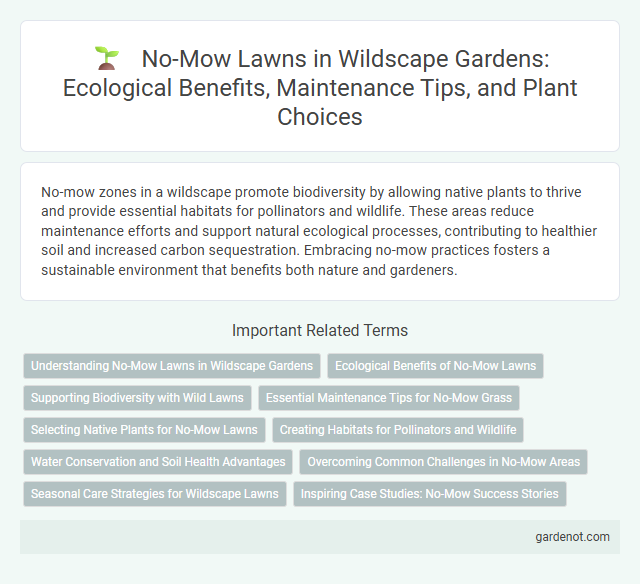No-mow zones in a wildscape promote biodiversity by allowing native plants to thrive and provide essential habitats for pollinators and wildlife. These areas reduce maintenance efforts and support natural ecological processes, contributing to healthier soil and increased carbon sequestration. Embracing no-mow practices fosters a sustainable environment that benefits both nature and gardeners.
Understanding No-Mow Lawns in Wildscape Gardens
No-mow lawns in wildscape gardens promote biodiversity by reducing lawn maintenance and allowing native plants to flourish, creating natural habitats for pollinators and wildlife. These lawns typically consist of a blend of native grasses and wildflowers adapted to local climate and soil conditions, enhancing ecosystem resilience. Adopting no-mow practices supports water conservation, minimizes chemical use, and encourages sustainable landscaping aligned with ecological principles.
Ecological Benefits of No-Mow Lawns
No-mow lawns support biodiversity by providing essential habitats for pollinators such as bees, butterflies, and beneficial insects, which contribute to ecosystem health. They improve soil quality by promoting natural microbial activity and reducing erosion through deeper root systems. These lawns also enhance carbon sequestration, helping mitigate climate change by capturing and storing atmospheric carbon dioxide.
Supporting Biodiversity with Wild Lawns
No-mow wild lawns create essential habitats for pollinators, native insects, and birds, fostering greater local biodiversity. By allowing native plants to flourish naturally, these lawns reduce the need for chemical fertilizers and pesticides, supporting healthier ecosystems. Wildscapes with no-mow zones enhance soil health and promote ecological balance, making them vital for sustainable urban and suburban environments.
Essential Maintenance Tips for No-Mow Grass
No-mow grass requires minimal upkeep, reducing lawn maintenance time by up to 70% while promoting biodiversity. Essential maintenance includes occasional mowing once or twice a year to control height and prevent thatch buildup, along with targeted watering during extended droughts to maintain root health. Regularly removing invasive weeds supports the natural resilience of no-mow lawns, creating sustainable and eco-friendly green spaces.
Selecting Native Plants for No-Mow Lawns
Selecting native plants for no-mow lawns in wildscape designs enhances biodiversity by providing habitat and food for local pollinators and wildlife. Opt for drought-tolerant, low-growing species such as creeping thyme, clover, and native ornamental grasses to maintain soil health while minimizing water use. These plants require minimal maintenance, reducing the need for mowing, fertilizers, and pesticides, thereby supporting sustainable landscaping practices.
Creating Habitats for Pollinators and Wildlife
No-mow areas support diverse native plant growth, providing essential nectar and pollen sources for pollinators like bees, butterflies, and hummingbirds. These habitats offer shelter and breeding grounds for various wildlife species, enhancing local biodiversity and ecological resilience. Maintaining no-mow zones reduces habitat fragmentation, promoting a balanced ecosystem within urban and suburban landscapes.
Water Conservation and Soil Health Advantages
No-mow landscaping significantly enhances water conservation by reducing irrigation needs, as native grasses and plants adapted to local climates require less frequent watering. This approach promotes healthier soil through increased organic matter retention and improved microbial activity, which supports nutrient cycling and moisture retention. By minimizing disturbance from mowing, soil structure is preserved, leading to better water infiltration and reduced erosion in wildscape environments.
Overcoming Common Challenges in No-Mow Areas
No-mow areas in Wildscape environments often face challenges such as invasive weed growth, uneven terrain, and soil compaction, which can hinder native plant establishment. Effective management strategies include targeted manual weeding, soil aeration, and selecting hardy native species adapted to local conditions to improve biodiversity and ecological resilience. Maintaining no-mow zones enhances pollinator habitats and reduces maintenance costs, promoting sustainable landscape conservation.
Seasonal Care Strategies for Wildscape Lawns
No-mow wildscape lawns rely on seasonal care strategies that enhance native plant resilience and biodiversity by minimizing mowing disturbances. In spring, targeted removal of invasive species and light pruning prepare the area for robust growth, while fall focuses on mulching and seed dispersal to support soil health and regeneration. Winter strategies emphasize leaving natural debris as insulation, promoting sustainable ecosystems that thrive with reduced maintenance.
Inspiring Case Studies: No-Mow Success Stories
No-mow landscaping has transformed urban green spaces by reducing maintenance costs and enhancing local biodiversity, as seen in projects like the Chicago Botanic Garden's prairie restoration that increased native pollinators by 40%. In residential settings, homeowners in Seattle reported a 50% reduction in water usage and a significant boost in beneficial insect populations after adopting no-mow lawns. These inspiring case studies demonstrate how embracing no-mow practices nurtures resilient ecosystems while promoting sustainable urban living.
No-mow Infographic

 gardenot.com
gardenot.com